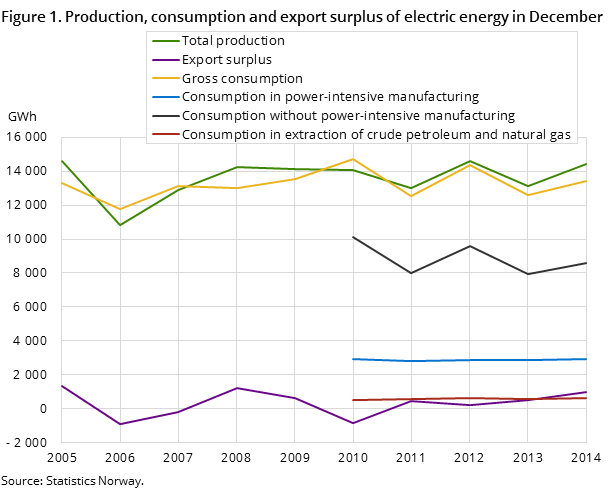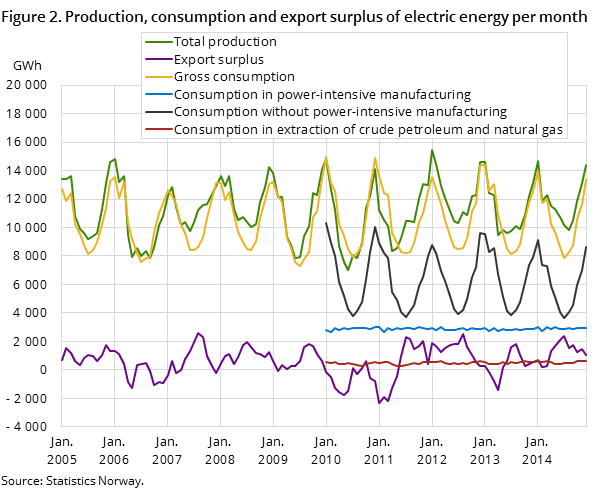Content
Published:
This is an archived release.
Higher electricity production
Electricity generation came to 142.3 TWh in 2014. This is 6 per cent higher compared with 2013 and the third highest figure ever recorded.
| December 2014 | Percentages | Change in per cent from the same month in last year | |
|---|---|---|---|
| Total production of power | 14 406 | 100,0 | 9.7 |
| Hydro power | 13 839 | 96.1 | 10.6 |
| Thermal power | 307 | 2.1 | -2.7 |
| Wind power | 260 | 1.8 | -13.1 |
| Net consumption of electricity | 12 174 | 100,0 | 6.5 |
| Consumption in extraction of crude petroleum and natural gas | 646 | 5.3 | 9.7 |
| Total consumption of electricity in power intensive manufacturing | 2 928 | 24.0 | 1.7 |
| Consumption without power intensive manufacturing | 8 600 | 70.6 | 8.0 |


The rise in the electricity production may be seen in conjunction with a larger inflow of water and higher filling during most of 2014 than the previous year. The building of power plants and upgrading of old power plants has also contributed to a higher production level over time.
Hydro power the dominating type of production
Hydro power accounted for 96 per cent of the total electricity production in 2014, while thermal and wind power accounted for 2.4 and 1.6 per cent respectively. Compared to 2013, there were only marginal changes in the shares of production.
Large net export of power
Norway’s export of power totalled 21.9 TWh in 2014, while imports came to 6.3 TWh. This gave a net export of 15.6 TWh. In 2013, there was a net export of 5 TWh. Exchange of power between countries is determined by disparities in generation, the consumption situation and prices, in addition to the capacity of the power lines. The large net export of power may be seen in conjunction with warm weather and a large inflow of water to the Norwegian reservoirs.
Decline in the total electricity consumption
The gross consumption of electricity came to 126.7 TWh in 2014; a decrease of 1.9 per cent compared with 2013. The gross consumption of electricity encompasses consumption in the groups extraction of crude oil and natural gas, power-intensive manufacturing and electricity consumption excluding power-intensive manufacturing and extraction. Net loss, pump storage use and other own consumption in the power stations are also included.
Decrease in the electricity consumption excluding power-intensive manufacturing and extraction
Electricity consumption excluding power-intensive manufacturing and extraction amounted to 72.7 TWh in 2014; a decline of 5.1 per cent compared with 2013. An important explanatory variable for the consumption excluding power-intensive manufacturing and extraction is temperature. Hence, the reduction in the consumption may be seen in conjunction with the higher temperatures in 2014. According to the Norwegian Meteorological Institute, 2014 is the warmest year in a time series dating back to 1900. Households, services and manufacturing other than power-intensive manufacturing account for the majority of the electricity consumption excluding power-intensive manufacturing and extraction. Electricity consumption in households amounts to approximately 50 per cent of the electricity consumption excluding power-intensive manufacturing and extraction.
Rise in the electricity consumption in power-intensive manufacturing
Electricity consumption in power-intensive manufacturing was 35 TWh in 2014. This is 1.9 per cent higher compared than in 2013. Power-intensive manufacturing utilises electricity for the production of goods. Hence, the electricity consumption is not influenced by temperature.
Increase in the electricity consumption in extraction of crude oil and natural gas
Electricity consumption in plants for extraction of crude petroleum and natural gas on the mainland, including electricity distributed from the mainland to the Norwegian shelf, amounted to 6.5 TWh in 2014. This is 5.6 per cent more compared with the previous year. The electricity consumption in extraction on the mainland encompasses receiving and processing plants for crude oil and natural gas.
Contact
-
Magne Holstad
E-mail: magne.holstad@ssb.no
tel.: (+47) 40 90 23 42
-
Ingvild Røstøen Ruen
E-mail: ingvild.ruen@ssb.no
tel.: (+47) 40 81 13 97
-
Tom Jonas Billit
E-mail: tom.billit@ssb.no
tel.: (+47) 40 81 13 45
-
Thomas Aanensen
E-mail: thomas.aanensen@ssb.no
tel.: (+47) 40 90 23 48
